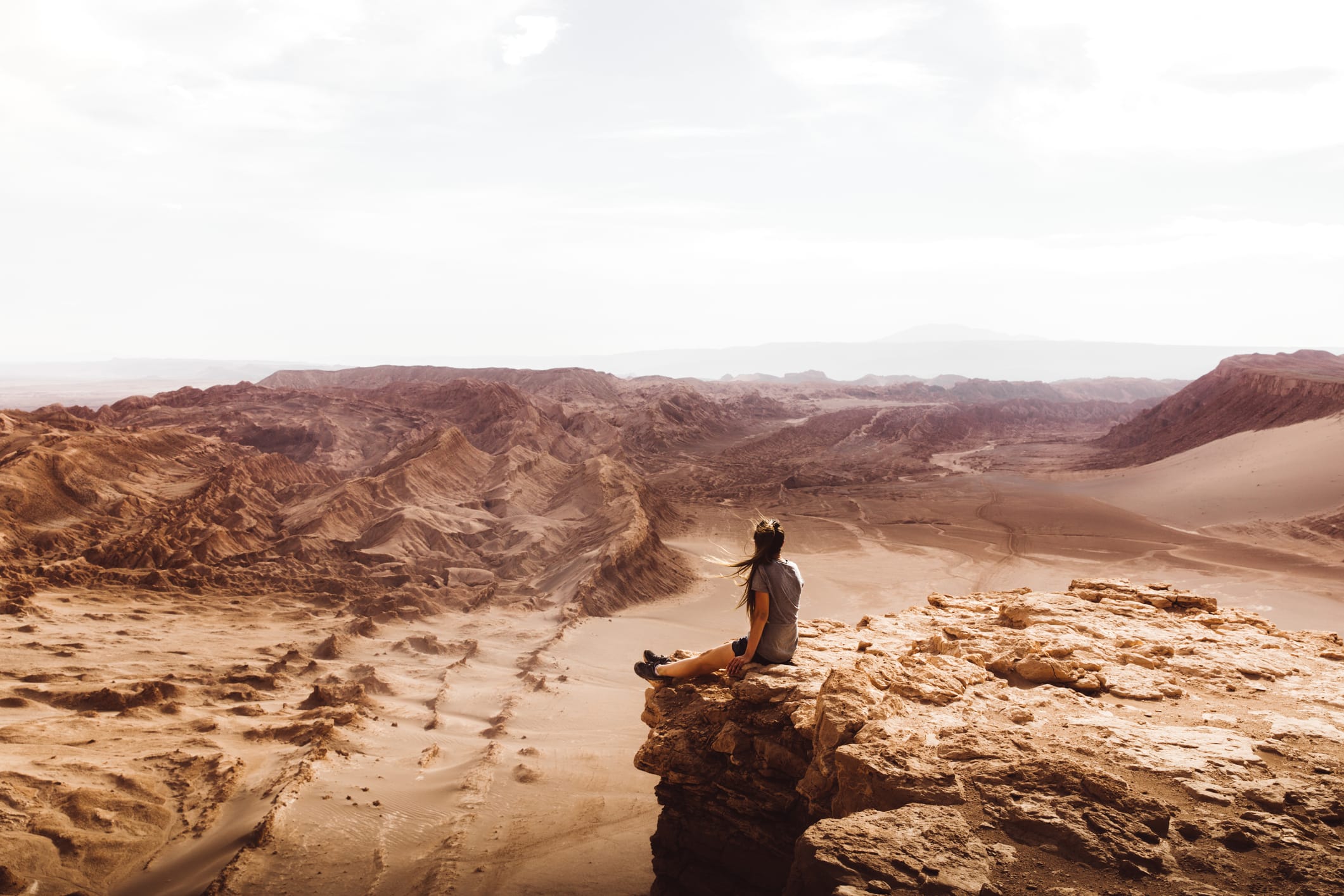
There is a reason that Chile is one of the hottest global traveler destinations these days, and the Atacama Desert is one of its shining stars.
Beige, rocky and seemingly lifeless, the north-easternmost part of Chile — generally regarded as the driest desert on earth — feels more like the surface of the moon than the blue planet Earth.
The Atacama Desert.
Peter Gabriels / EyeEm
It is mesmerizing and beautiful — a rugged landscape of craggy outcrops, flat mesas and vast sand dunes ringed by volcanoes that contrast against a brilliant sky. It is this very starkness which dazzles, as the mind explores how a place so dry and desolate can pack so much interest and excitement.
The gateway to the desert — San Pedro de Atacama
With fewer than 2,000 residents, the town of San Pedro de Atacama is a compact collection of small adobes and wooden buildings, nothing over two stories high.
The town is more than 1,000 miles from Santiago, but has no airport. Streets are made of dirt, with no stoplights, and there is just one petrol station in 60 miles.
A street in San Pedro de Atacama.
Prisma by Dukas | Universal Images
San Pedro de Atacama is a simple town, perfect for walking, with narrow streets stretching from the center outward until they simply disappear into the desert.
The main street, Caracoles, is lined with petite galleries, shops, tour operators and restaurants — nearly all merchant-owned and very friendly. Just a block away is the idyllic little Plaza De Armas — a common name for the center of Spanish colonial towns— which is anchored by an adobe church.
The door of the Bell Tower of San Lucas — made of cactus wood — in Toconao, near San Pedro de Atacama.
Wolfgang Kaehler
Strolling along the dusty streets between low-slung colorful buildings with cactus wood doors, everything one wants to buy, drink and eat is available, including the ever-popular La Frenchuteria bakery — whose authentic French bread is claimed by many as some of Chile’s best despite the bakery’s extreme remoteness from, well, everywhere.
The extraterrestrial outskirts
If San Pedro de Atacama is a beehive of light-handed tourism, the outskirts are nature in her most austere, elemental state. Just outside of this bustling little town is an emptiness that feels extraterrestrial — an endless vista of barren beauty and natural harshness that is nevertheless accessible by car.
This is where the exploration begins. Trek and tour the Licancabur and Jurique volcanoes, gape at the aptly-named Valle de la Luna (Moon Valley) in Los Flamencos National Reserve, explore jagged canyons, pick through caverns and even “snowboard” down enormous sand dunes (rental equipment is available in town).
Sandboarders surfing the Death Valley dunes near San Pedro de Atacama.
Andia
Farther away, it’s possible to float effortlessly in the salt water ponds of the Salar de Atacama Salt Flats. Beyond, the Miscanti and Miñiques lagoons await in windy isolation, so blue and pristine that you’d swear they were artificial.
Floating in the salt lagoons of the Atacama Desert.
Martinelli73
Along the way, small adobe villages are good stops to sample dried fruits, nuts and stews, and there is a spot to straddle your feet across the Tropic of Capricorn in the utter absence of anyone else.
Atacama at night
When the sun drops behind the flat tops of the area’s volcanoes, the sky rains with the light of thousands of flickering dots and streaks tearing across the galaxy.
Indeed, the night sky of Atacama is considered among the clearest anywhere. At more than 8,000 feet above sea level and almost entirely free of ambient nighttime light, the desert is home to many of the world’s most important observatories, including the ALMA telescope, the largest radio telescope in the world.
Several of the 66 antennas that make up the ALMA (Atacama Large Millimeter/submillimeter Array) telescope, a partnership project between Europe, North America, East Asia and Chile.
MARTIN BERNETTI
This type of telescope isn’t needed for awe-inspiring stargazing, and having an astronomer explain the night sky with laser pointers is an incredible experience that can be easily arranged by most hotels.
Sunrise with geysers
No visit to Atacama is complete without a frigid pre-dawn journey to El Tatio Geysers.
After a 50-mile drive north in the dark and a climb (by car) of several thousand feet, the landscape reveals hundreds of natural steam geysers bubbling and spewing under the sunrise.
El Tatio Geyser Field.
Henryk Sadura
As the sun peeks above the jagged mountains and the geysers subside, it’s time for breakfast — either at the tiny villages on the journey back for fresh-grilled guanaco (similar to llama) or rolling right into San Pedro to the popular Roots cafe.
Later, a stroll to the local open-air market — little more than an alley covered with a plastic tarpaulin — offers the chance to pick up fresh fruits and vegetables for a desert picnic later that day.
Hotels – boutique, all-inclusive or luxury
Despite its popularity, the Atacama has been overlooked by big box hotels, populated instead by boutique chains and desert-style independents.
A guanaco — closely related to the llama — in the Atacama Desert.
Veronique Durruty
One such place is the Noi Casa Atacama, a mix of comfort, luxury and desert simplicity. A few all-inclusive resorts, like Explora, have everything one needs in private surroundings and activities. And for memorable five-star accommodations, the Awasi Atacama has unparalleled exclusivity, blending Relais & Chateaux luxury with a bespoke desert experience.
Tips
Getting there: To get the Atacama, fly to the town of Calama, then drive nearly two hours through the Chilean portion of the Altiplano, the wide high plains desert that extends into Bolivia, Peru and Argentina.
Getting around: The best way to experience the Atacama is by car at your own speed. Rentals in town are easy, but it’s best to reserve a four-wheel drive vehicle ahead of time. The few paved roads lead to dirt and gravel, but all are well-marked and easy to manage.
What to wear: Desert temperatures fluctuate. Nights and mornings can be cold, so dress in layers. In the summer (November through February), bring along shorts, tees and lots of sunscreen.

